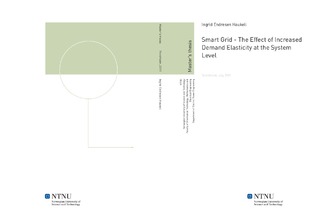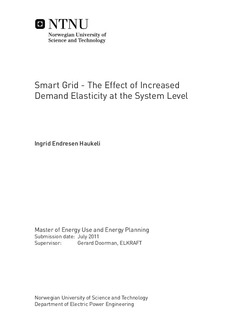| dc.contributor.advisor | Doorman, Gerard | nb_NO |
| dc.contributor.author | Haukeli, Ingrid Endresen | nb_NO |
| dc.date.accessioned | 2014-12-19T13:52:46Z | |
| dc.date.available | 2014-12-19T13:52:46Z | |
| dc.date.created | 2011-09-21 | nb_NO |
| dc.date.issued | 2011 | nb_NO |
| dc.identifier | 442305 | nb_NO |
| dc.identifier | ntnudaim:6239 | nb_NO |
| dc.identifier.uri | http://hdl.handle.net/11250/257097 | |
| dc.description.abstract | It is in this report given an analysis of the effect of utilizing load control in the Norwegian power system, which is one of the functions included in the Smart Grid consept. The analysis is performed by running simulations in the EMPS model. Effects are investigated in terms of increased socio-economic surplus in Norway and reduced prices during peak load periods in the area Østland.Based on earlier studies it is assumed that it is possible to disconnect 600 MW of electric water heaters during peak load hours without reducing any comfort for customers. In this analysis, 600 MW is shifted from two peak load hours to a low load period, implying that 6 GWh/week (600 MW*2h/day*5 days/week) is shifted from peak load periods to low load periods.Simulations using the existing model of the Nordic system show a net increase in socio-economic surplus of 20.208 MEUR per year by implementing a load shift. The average prices during the peak load periods are in this case reduced by 0.06 cent/kWh. In an extreme situation, a price reduction of 33.02 cent/kWh is observed. Including variation of wind power production in these simulations shows that the average price reductions are smaller and that the effect obtained in extreme situations is significantly smaller. This indicates that the effect of a load shift is somewhat smaller than what the results in the other simulations have shown.An improved system model, where the functions quadratic losses and gradual consumption adaption are included, give that a load shift increases socio-economic surplus by 41.198 MEUR per year. The average price reduction are found to be about the same as obtained by the original model. The price reductions in extreme situations are however considerably lower.Varying the exchange prices with the continental areas gives increased price differences between the price periods, which results in an even larger effect of load shift. The effect is especially large in a scenario where the prices in Germany and the Netherlands are very low during off-peak periods due to increased wind power production while the peak prices are high due to use of gas power plants instead of coal. An average peak price reduction of 0.07 cent/kWh and a price reduction of 10.48 cent/kWh during extreme situations are here found.Some uncertainty is connected to the results due to difficulties when comparing results from different simulations, which occurs when the calibrating the models. However, the results still indicate the range of the values that a load shift provides, which is clearly positive. | nb_NO |
| dc.language | eng | nb_NO |
| dc.publisher | Institutt for elkraftteknikk | nb_NO |
| dc.subject | ntnudaim:6239 | no_NO |
| dc.subject | MTENERG energi og miljø | no_NO |
| dc.subject | Energibruk og energiplanlegging | no_NO |
| dc.title | Smart Grid - The Effect of Increased Demand Elasticity at the System Level | nb_NO |
| dc.type | Master thesis | nb_NO |
| dc.source.pagenumber | 130 | nb_NO |
| dc.contributor.department | Norges teknisk-naturvitenskapelige universitet, Fakultet for informasjonsteknologi, matematikk og elektroteknikk, Institutt for elkraftteknikk | nb_NO |

